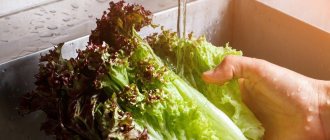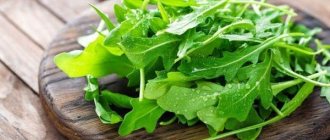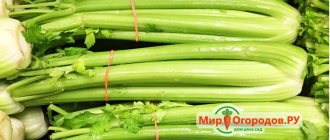Salad in plastic packaging is in great demand among lovers of healthy eating. Manufacturers indicate that it is ready to eat and there is no need to wash arugula and lettuce. Plus, it looks fresh, as if it was picked from the field just a few hours ago. But is it safe to eat it in this form and will such “conditionally healthy” food harm the body?
Mixed salad is a delicious and healthy component of dishes
A colorful cocktail of spicy and tender leaves is an excellent ingredient for salads and a juicy garnish for main dishes. However, without knowing the subtleties of culinary skills, it is easy to spoil the taste and appetizing appearance of the food. How to properly prepare the gifts of nature and create a mix?
Mixed salad - an assortment of prepared salad greens, without vegetables, dressing or spices. The Persians began mixing succulent plants: they tore them with their hands and seasoned them with vinegar and olive oil. In France, a handful of spicy leaves were served with roasts, after which they began to add vegetables and cheeses, and experiment with all kinds of sauces. The overall flavor of the dish depends on the composition of the mix, but first of all, the ingredients must be juicy, not spoiled and hold volume well.
How to properly wash lettuce?
It is recommended to wash salad leaves under running water, but small grains of sand can get lost between the stems and end up in the dish. It is more effective to soak in plenty of water so that the greens do not touch the bottom of the dish. Cooking is a complex science: even such a simple process has nuances.
Leaf salads need to be properly prepared:
- Rinse the chicory and radicchio under running water and cut out the head completely without tearing off the leaves;
- Sort through the mash salad and carefully tear off the root so that the emerald leaves do not fall apart;
- Remove stems from arugula and spinach (conveniently using scissors);
- The iceberg is washed under running water only from the top;
- For head lettuces, cut the stalk and separate the leaves if they do not fit tightly together (romaine, boston, frise), and lollo rosso and bionda can be torn before washing.
Fill a large container with cold water, carefully place the greens and leave for 10 minutes. The grains of sand are heavier than the liquid and will easily settle to the bottom of the dish. Collect lettuce leaves, transfer to another container, change the contents and throw in the greens again. It is advisable to rinse about 3 times until the bottom is clean.
The beauty will not deteriorate if the water is constantly changed. It is better to pay more attention to corn, spinach and Boston, as they do not like to bathe.
Almost every leaf has bitterness, which can overpower the delicate flavor. If you reduce it a little, you will notice amazing nutty and spicy notes. In restaurants, lollo rosso, arugula, endive, frisee and radicchio are left in water for several hours, changing every 20 minutes.
It is recommended to wash lettuce leaves separately and dry them in a centrifuge. Place in a net carefully and in small portions (especially romaine and lollo), practically folding leaf to leaf, otherwise they will break, lose valuable juices and quickly wither. It is advisable to stop the device several times while spinning, lift the lid and stir the contents. After each use, drain the accumulated water. Chicory, radicchio, and iceberg are not dried in a centrifuge: after washing, they are wiped and the mixture is prepared. It is better to store them entirely in the refrigerator, first wrapped in cling film. Mung bean salad and other tender greens are placed on a waffle towel and turned over periodically. It is better to tear the prepared leaves with your hands: the mixed salad turns out more beautiful and juicy. For some dishes, you can cut with a knife, but the blade must be sharp and made of stainless steel.
Use in cooking
In cooking, iceberg is most often used as one of the components of salad. Its peculiarity is the ability to visually increase the portion and fill the dish with vitamins.
What can you cook?
Iceberg harmonizes well with meat and fish and is suitable as an addition to an appetizer. The prepared dish is placed on lettuce leaves and served. The neutral taste of iceberg does not overwhelm the main products, so it is added to vegetables, cheese and side dishes.
The good thing about iceberg is that it retains its crunchy texture when soaked in sauce. Even in the famous “Caesar”, recently they began to add not the original Romano leaves, but iceberg. Moreover, you can add iceberg lettuce to borscht. This cooking method has become popular only recently, but is already loved by many chefs.
How to wash properly?
To properly wash a head of lettuce, just place it under running water and clean it of small contaminants. There is no point in deliberately cutting and washing each leaf, since the head of cabbage is tightly formed, and the inner leaves always remain clean.
If the iceberg was cut and packaged when purchasing, you should remove the lettuce and also rinse it under running water.
How to cut?
It is not recommended to cut the salad, because it can lose its freshness, crunch of leaves and nutrients. To add salad to a dish, it is recommended not to cut it, but simply break it with your hands.
How to remove bitterness from salad?
To remove bitterness from salad, you can use several simple methods:
- Soak the leaves for 10-15 minutes in cold water with a few drops of vinegar.
- Before cooking, leave the torn leaves for 20 minutes and only then add the rest of the ingredients.
- Add a few drops of lemon juice to the finished dish.
- Immerse the lettuce leaves in a container of water for several hours.
What can I substitute in the recipe?
You can replace iceberg in the recipe with other types of vegetables: Chinese or white cabbage, lettuce or arugula. The dish will have an excellent taste with any replacement, the only thing is that no salad can provide the unique crunch of an iceberg.
We recommend reading: How to Freeze Oyster Mushrooms at Home for the Winter
Iceberg is able to diversify the standard diet in case of illness, as well as saturate the body with useful substances.
Gastritis
If gastritis worsens, it is better to spare the gastric mucosa and stop eating iceberg. But during the period of remission, salad is useful: it does not burden the stomach, but provides nutrients.
Diabetes
Iceberg lettuce is allowed for diabetes. It does not cause side effects; on the contrary, it can improve the well-being of patients.
Pancreatitis
For pancreatitis, you should adhere to the same rules for eating salad as for gastritis: during an exacerbation it is prohibited, and during remission it is allowed to be used as food.
Gout
Gout is one of the rare prohibitions for eating iceberg. Excessive consumption of salad can provoke an exacerbation of the disease, so you should eat it with great caution.
- You need to water the lettuce both in the garden bed and on the windowsill regularly - do not allow the soil to dry out.
- The first loosening is carried out 3 weeks after planting, and all subsequent ones - after each watering.
- Weed removal is carried out if necessary.
- Feeding should consist of a complex of substances necessary for the plant: phosphorus, potassium, magnesium and nitrogen.
Iceberg lettuce (Crisphead or “Ice Mountain”) is a representative of the vegetable crop; it belongs to the head-type salads, such as lettuce. The leaves are pale green, wrapped in juicy, dense heads. Iceberg lettuce was grown by the ancient Egyptians, but was used for its seeds and oil.
Externally, the salad is similar to white cabbage, the average weight of one fruit can reach 400 - 500 g. The high concentration of water in Iceberg lettuce makes it crispy, pleasant, but not very pronounced in taste. This plant got its name in America because ice (ice) was used for transportation.
How to prepare a mixed salad?
A lush leaf cocktail with an exquisite taste and beautiful color scheme is the foundation of a delicious dish. It’s better to take lollo rosso and bionda as a basis (30% in total), throw in arugula and frisee curls (20% each), and diversify with beautiful rosettes of corn, young spinach leaves, and Boston hearts (15-20% in total). To highlight the variegated green colors, you can add radicchio checkers (10%), and before eating, complete the palette with watercress or chicory (5% only). If desired, you can add other leaves. It is better to use romaine separately; frisee and a couple of sprigs of arugula are sometimes added to the iceberg.
In the mixes, piquant and spicy leafy salads should predominate, leaves with a neutral taste should be added a little less, spicy and bitter herbs should be added a little to slightly highlight the taste of the green mass.
When composing a platter, it is advisable to take into account the ingredients of the dish and its dressing, because delicate greens will settle under the weight of thick sauces. In restaurants, arugula and frisee (up to 60%) are often used as the basis for cocktails, because they go well with any dressings and do not lose their presentable appearance.
It is advisable to mix the greens with your hands, wearing a disposable glove, or, in extreme cases, with two wide salad spoons. The fragile leaves are easy to break, after which they quickly lose their shape, and the dish turns out unappetizing. The seasoned mix should turn out beautiful, fluffy and light. If the salad includes coarsely chopped vegetables and a thick, rich sauce, it is better to season the delicate cocktail with olive oil and place the hefty ingredients on top. The composition will be voluminous and beautiful.
The prepared leaf salad cocktail should be placed in a plastic container and tightly closed. It is advisable to place a waffle towel on the bottom of the dish: droplets of water will be absorbed and the greens will remain dry and fluffy. It is better not to use paper napkins: the leaves will wither faster. A properly prepared mix can last in the refrigerator for 3-4 days! If the leaves are slightly wilted, they should be kept in cold water for 10-15 minutes and dried.
With the help of a mixed salad, you can make any dish more vibrant and spicy, saturate it with vitamins and valuable substances, and easily adjust the aftertaste.
Mixed salad - an assortment of prepared salad greens, without vegetables, dressing or spices. The Persians began mixing succulent plants: they tore them with their hands and seasoned them with vinegar and olive oil. In France, a handful of spicy leaves were served with roasts, after which they began to add vegetables and cheeses, and experiment with all kinds of sauces. The overall flavor of the dish depends on the composition of the mix, but first of all, the ingredients must be juicy, not spoiled and hold volume well.
How to get rid of bacteria and harmful substances?
Based on the research results, we can conclude: salad must be washed before use. Even if this does not help get rid of all harmful substances and microorganisms, washing will still reduce their number to an acceptable level.
We recommend: What messages on your phone should be deleted immediately after reading: they can help attackers steal your money
How to wash properly?
To destroy the maximum amount of pathogens, you need to wash arugula and lettuce in several stages:
- First, the leaves are placed in ice water for a few minutes.
- Then let it dry a little.
- After this, rinse under cold running water for 1–2 minutes and wait until dry.
- Then wash thoroughly in warm water, cleaning each leaf.
After this, the product is ready for use.
This method is necessary for children and people with poor health, especially for those who suffer from diseases of the digestive system. For healthy adults, it is enough to rinse well in running water at room temperature.
How to choose leafy vegetables in the store?
To reduce the risk of infection, you need to follow the rules for choosing ready-to-eat products:
- Monitor the quality of packaging. It must be sealed, free of damage and excess gas. Swollen bags should be discarded immediately.
- Pay attention to the expiration date. The product must not be expired. In addition, it is better not to take salad, which should spoil in 3-4 days. It already contains a large amount of harmful substances.
- Read the ingredients carefully. The fewer preservatives it contains, the more healthy it is.
- Do not choose the cheapest product and give preference to trusted manufacturers. As a rule, low-cost products contain large amounts of bacteria and harmful elements.
- Store lettuce, arugula, and Chinese cabbage in the refrigerator and consume as soon as possible after purchase. This will reduce the risk of proliferation of harmful organisms.
- If possible, buy not ready-to-eat salad from plastic packaging, but a fresh product at the market. It still needs to be washed thoroughly, but the leaves will likely contain fewer pesticides and chemicals.
The best and safest option would be to grow arugula or lettuce in a pot on the window - this will allow you to get fresh and natural products at any time of the year.
Lettuce and arugula leaves - even in packages labeled “Ready to Eat” - always contain large amounts of substances harmful to health. Therefore, to the question of whether it is worth washing them, the answer is clear: definitely! A few minutes spent on this procedure can prevent unpleasant consequences and maintain health.
We recommend: We tell you how Coca-Cola, potatoes and a battery effectively clean a rusty barbecue grill
How to quickly dry lettuce
In home kitchens in Russia, green salad leaves have become popular relatively recently. And that's great! They add a lot of variety to the table, especially in winter, when the body lacks vitamins and minerals! Before preparing the salad, it must be thoroughly washed and dried . Well, as a rule, there are no problems with “washing”. But it’s problematic to dry these crispy leaves, which don’t want to part with water at all, without special salad drying. Of course, you can patiently wipe each leaf with a napkin, but I know how to speed up this process and I want to share with you. I promise it will be fun!
Benefits of iceberg lettuce
During the program we decided to compare regular cabbage and iceberg lettuce. Salads are very popular today. Advertising plays a role in this. But what to prefer, what to choose – regular cabbage or iceberg lettuce. is considered to be more tender.
You need to understand that both cabbage and iceberg contain a lot of coarse fiber. People prefer iceberg for salads, and cabbage for borscht. But the salad can also be made from cabbage, which can be finely chopped.
Iceberg is similar to cabbage in appearance and properties. Cabbage contains more coarse fiber. And an iceberg contains more nutrients. cannot buy iceberg but cabbage stores well.
Fresh iceberg leaf can be made quickly, but you can also use sauerkraut. Iceberg lettuce contains slightly less calories, but this is a minor difference. The iceberg contains more water.
There are lettuce leaves that are sold in packages that say you don’t need to wash them. But the program decided to conduct an experiment to understand whether there are bacteria on such a clean salad. was determined .
It turned out that it is better to buy the whole iceberg and wash it thoroughly and carefully at home. Don't trust signs that say you don't have to wash the salad. There are a lot of bacteria on this salad.
The program included a salad made from iceberg lettuce and boiled or smoked turkey. The sauce is made from mustard with honey, lemon juice and butter. Add a little yogurt with honey and salt. This will be extra sauce. You can add pine nuts and any berries to the salad.
We remind you that the summary is only a brief summary of information on this topic from a specific program; the full video release can be viewed here About the most important issue 1392 of December 15, 2015
Fresh iceberg leaf can be made quickly, but you can also use sauerkraut. Iceberg lettuce contains slightly less calories, but this is a minor difference. The iceberg contains more water.
Useful properties of Iceberg lettuce
So, what are the benefits of Iceberg lettuce for the body?
- Iceberg lettuce is a low-calorie product. It can be successfully used as a dietary supplement.
- Folic acid contained in salad is a necessary component for the full development of the fetus and the health of the pregnant woman; it helps regulate metabolism.
- Consumption of this vegetable helps normalize the functioning of the nervous system.
- Fiber in Iceberg lettuce improves digestive processes, helps normalize acidity and ensures normal stool.
- Juice based on lactarin, substances contained in the product, is used as an anesthetic.
- This salad is recommended for those who engage in mental activity. If possible, it is necessary to include Iceberg lettuce in the diet of school and university students.
- Substances contained in Iceberg lettuce promote blood renewal.
- Iron-rich heads of cabbage are recommended to be eaten for anemia.
- Eating iceberg lettuce during the winter months helps boost your immune system.
- Recommended as a preventative against cancer, as well as for people with high cholesterol levels.
- Iceberg lettuce is also good for people with heart disease. Can be used as a prophylactic against strokes and atherosclerosis.
- Phosphorus, calcium and magnesium, which are part of the vegetable crop, promote immunity, and the microelements in its composition will serve as protection against bacteria and various viral diseases.
- The product is also useful for salt deposits, obesity, and diabetes.
Iceberg salad with cherry tomatoes
Cherry tomatoes - 350 grams, cucumbers - 350 grams, onion - one piece, Iceberg lettuce - 250 g, cilantro - 60 g, parsley - 60 grams, cheese (preferably Parmesan) - 30 grams, mustard, garlic, salt to taste.
Dry the vegetables, wash and cut into large cubes. Chop onion, parsley, cilantro. Place in one bowl, mix, add salt. Prepare the gravy: mix mustard with sour cream, garlic and cheese, pour everything in, stir.
Iceberg salad with pineapples
350 grams of boiled rice, 450 grams of pickled champignons, 450 grams of canned pineapple, one onion, 60 grams of Iceberg lettuce, 150 grams of green onions, a couple of cucumbers, 250 grams of mayonnaise, 60 grams of vegetable oil, salt as needed.
We recommend reading: How to Preserve Green Dill Umbrellas
Peel, chop the onion, fry it in heated sunflower oil. Drain the champignons through a colander and cut into small cubes. Mix the champignons with the golden onions and fry it all for about 6 - 7 minutes.
Cook the rice over low heat. It is the top layer of the salad. Place on a dish, after greasing with mayonnaise. The next layer is mushrooms with onions, then Iceberg lettuce, then mayonnaise. Pineapples must be cut into small cubes.
Lay out the salad, after adding plenty of mayonnaise, add salt as needed.
Chinese cabbage salad
Regular cabbage 350 g, Chinese cabbage 350 g, one avocado, a couple of cucumbers, pine nuts 150 grams, lemon juice - 4 tablespoons, olive oil - 150 grams, salt to taste.
Cut the cabbage into thin strips, cut the Iceberg lettuce into strips, and cut the bell peppers in the same way. Finely chop the parsley. After removing the seeds, we clean the avocado, then cut it into cubes and add lemon juice. Cut the cucumbers into strips, fry the pine nuts in a frying pan. Mix all ingredients adding olive oil and salt to taste.
How to make Iceberg salad with basil
1 head of Iceberg lettuce, a couple of tomatoes, one fresh cucumber, cheese - 250 grams, basil - 15 grams, salt to taste, pepper - half a teaspoon, 60 grams of water, vinegar to taste, sugar - one teaspoon, dry white wine - 2 tablespoons, vegetable oil - 3 tablespoons, half an onion, spices as needed.
We wash the lettuce and cut it into leaves. They need to be torn into large pieces. Tomatoes must be peeled and cut into cubes. Similarly, cut the cucumber, finely chop the onion and basil. Cut the cheese into cubes.
Mix it all in one bowl and stir. Beat vinegar, spices, water, wine, sugar and pepper in a blender and season with this sauce.
Salad with canned mushrooms
1 head of Iceberg lettuce, 250 grams of pickled mushrooms and pineapples, 3 smoked hams, 150 grams of crackers, 200 grams of mayonnaise, one onion, 60 grams of vegetable oil, separate the ham from the bone and cut into small pieces. Pineapples in cubes, fry chopped onions in vegetable oil, add champignons. Fry for 5 minutes.
The described vegetable is washed with water and disassembled into pieces, then it is necessary to cut or tear it into large pieces. All products are mixed in one bowl.
Iceberg lettuce, 200 g
Iceberg lettuce - already washed, chopped, fresh, ready for immediate use. It really helps after work - the salad is ready in a matter of minutes!
Ingredients: iceberg lettuce Information on the label may vary slightly. This product may be supplied by several manufacturers. For this reason, product information on the website may vary slightly. The data corresponding to a specific product is always presented on the label. The appearance of the product in the store may also differ from the image in the photo.
- Expiration date: 6 days
- Weight: 200 g
Only for purchased goods
Iceberg lettuce - already washed, chopped, fresh, ready for immediate use. It really helps after work - the salad is ready in a matter of minutes!
The salad is in a very convenient transparent package, you can see the quality of the salad, it tastes very juicy and tender with a slightly sweet taste, you can make a variety of salads from it, it goes well with tomatoes and cheese, every morning I make a healthy, tasty breakfast from this salad. Thank you
I buy iceberg lettuce as a base for a lunch salad. I add tomato, cucumber, oil and a little soy sauce. And if you buy, in addition, julienne in a pancake, also in BB, as I did today, then a delicious lunch is ready in 5 minutes. The leaves are not withered, fresh, despite the fact that the expiration date was coming to an end. I was pleased with the price, quality and taste of the salad. So a solid five!
I've been eating Iceberg lettuce for a long time. I like it because I don’t have to separate the leaves from the head; I like the format of ready-to-use greens. I use it mainly in salads with tomatoes and cucumbers, sometimes I add mozzarella. The salad is not always fresh and unoxidized, like today’s example, this is upsetting; I would like VkusVill to monitor the supplied product more carefully. In general, I really like Iceberg, it pleases with its juiciness, coolness, and freshness. I also consider the quantity of the product to be optimal, but perhaps for other buyers it will also be beneficial to take whole heads of cabbage or other formats of ready-made salad (500g or 100g)
How to choose?
When choosing a salad you need to pay attention to:
- Form. The head of lettuce should be formed, symmetrical and compact enough so that the leaves do not separate on their own.
- Weight. The optimal weight at which a head of cabbage is considered mature and maximally saturated with beneficial properties is 400-500 g.
- Leaves. They should be firm, crispy, juicy and have a bright natural color.
- Package. If the product is cut and packaged, it is worth assessing the integrity of the packaging and the appearance of the leaves: darkened, dry or limp leaves indicate that the product is not fresh.
- Packaging time. It is best to choose recently packaged heads of cabbage: they can maintain freshness for a long time.
The freshness of a head of cabbage can be determined by its density. The denser the structure, the later the lettuce was harvested, which means the product has lost its beneficial qualities and original taste.
Accustomed to lettuce. How to deliciously cook arugula, iceberg and other healthy herbs
We bet you're not used to seeing a bunch of lettuce varieties in your refrigerator. That's right: the place for them is in the stomach. Today you will learn how to understand this herb and cook it deliciously.
Text: Maria Mikulina Photo: Nikolay Gulakov Illustrations: Sergey Radionov
It is customary for men to be suspicious of food that: a) is not suitable for the microwave; b) is not provided with instructions; c) when you catch her and take her home, she can’t suddenly wake up and kill you.
Lettuce and other plants do not tick all the boxes at once, so there are usually only a few of them in your diet. And in vain! Not only does the salad have a lot of useful properties (you can even make Panama from some varieties), it is also easy to prepare. And so that instead of the right leaves you don’t pick up weeds in the store, we have compiled a culinary and botanical atlas for you.
Iceberg cabbage: varieties, care, propagation and beneficial properties
- View the full image
Iceberg cabbage
Iceberg cabbage varieties
Iceberg cabbage care
Iceberg cabbage propagation
Beneficial features
Lettuce is a plant that has a lot of vitamins and is distributed on almost all continents. There are a huge number of species and varieties that can be grown at home in a summer cottage or even on a balcony.
- Iceberg cabbage varieties
- Iceberg cabbage care
- Iceberg cabbage propagation
- Beneficial features
We recommend reading: How to Store Green Peppers to Ripe Faster
Arugula
Also known as caterpillar and indau sativum, but only on the territory of biological institutes. Looking for it under these names on the market is pointless and dangerous.
Green uniform rich color, leaves are dissected into toothed lobes. She looks like an oak leaf that skipped physical education.
Improves digestion. It has lactogenic (increases the amount of milk in women), diuretic (reduces the amount of urine in men) and antibacterial (you already know this) properties. The anti-cancer effect of arugula, which is usually trumpeted in other, incompetent journals, has not yet been confirmed by science, however, arugula contains a lot of glucosinolates (substances that delayed the development of cancer in mice in some experiments). Because of them, by the way, the salad is bitter.
The Romans were the first to meaningfully look at their feet and discover that arugula can not only be trampled, but also eaten. They also own the hitherto unconfirmed myth that arugula is a powerful aphrodisiac. Arugula began to be grown en masse only in the 20th century, which once again proves how reluctantly humanity mastered salads.
What does iceberg lettuce look like?
Iceberg lettuce is an ancient vegetable crop. It is a type of lettuce that has smaller, curly leaves. In appearance it is similar to white cabbage. It is characterized by the same round shape of the head as cabbage; it is a cruciferous vegetable, but is a leaf lettuce. The light green leaves do not fit as tightly together as in cabbage, so they are easily separated from each other. If the leaves are difficult to separate, then such a salad is considered to be overripe. Its taste is impaired. It may be slightly bitter.
Iceberg lasts much longer than other leaf lettuces. It can be stored in the refrigerator at temperatures from -2 to +5 degrees for up to 5 days. Some housewives recommend wrapping the salad in a wet napkin and putting it in the refrigerator. This way it is possible to significantly increase its shelf life. You need to remember that the fresh product is elastic and crispy, and this is its beauty. If these qualities have changed, it is unlikely that you can fully enjoy such food.
How it is
Arugula, being Italian, goes well with the corresponding cuisine. For example, it is added to pizza. If you don’t have pizza at hand...
Cut 300 g of chicken fillet into small pieces, add salt and pepper, add 2 tbsp. l. lemon juice and leave for 15 minutes. Let 250 g of pasta cook (any kind, but tagliatelle is better). While the water is boiling, tear off the stems from a bunch of arugula and place the leaves in a blender along with a clove of garlic, a few basil leaves, 1 tbsp. l. lemon juice and 1 tbsp. l. olive oil . Stir until smooth and pour the resulting sauce over the mixture of pasta and fried chicken.
How to cook arugula
Arugula pesto recipe
- 150 g arugula leaves (3 full handfuls)
- 70 g pine nuts (optional cashews, walnuts or sunflower seeds)
- 3-4 tablespoons olive oil
- clove of garlic
- tablespoon grated parmesan
- tablespoon lemon juice
- salt and pepper - quantity at your discretion
Rinse the arugula leaves under running cold water, and lightly fry the nuts in a dry, heated frying pan. Place all the ingredients in the container of a food processor (you can use a regular bowl and a blender) and, gradually increasing the speed, beat everything into a homogeneous (but not necessarily smooth, ideal) mass. That's all - the pesto is ready.
You can eat the sauce with your favorite pasta, use it instead of tomato sauce on pizza, or stuff it on chicken breasts. Arugula pesto makes a great addition to a crispy baguette.
Salad with arugula and chicken
- 1 double chicken breast
- packaging of arugula (the quantity can be taken at your discretion, depending on the degree of love for this vegetable)
- 250 g cocktail tomatoes
- tablespoon lemon juice
- 3 tablespoons rapeseed oil
- 4 tablespoons olive oil
- salt and freshly ground pepper
- 1/2 teaspoon hot paprika
- 1/2 teaspoon sweet paprika
- teaspoon mustard
- You can also add a pack of small mozzarella balls
Mix 3 tablespoons of rapeseed oil, salt, ground hot and sweet pepper and rub the marinade prepared in this way over the halved and cleaned chicken breast. Place in a heatproof bowl, cover with cling film and refrigerate for at least half an hour.
During this time, rinse the arugula and tomatoes under running cold water and dry. Cut the tomatoes into quarters or halves.
It's time to make the vinaigrette - pour lemon juice into a bowl, add salt and mustard. Mix everything together, add olive oil and whisk until the ingredients are combined. Season to taste with salt and pepper and you're done.
When the meat is marinated, place the dish with the chicken in the oven, heated to 180 degrees, for 40 minutes. Cut the breasts baked during this time into strips. Place arugula in a bowl, add tomatoes and chicken pieces and pour vinaigrette over everything.
Because You are not logged in. To come in.
Because you are not a trusted user (phone number is not verified). Enter and confirm your phone number. Read more about trusts.
Have you ever wondered why these salads are cut up in a package and do not spoil for a week or two, or even more? Of course, I guessed that they were treated with something, so I still always washed them before using them, despite the convincing inscription on the packaging “No need to wash!”
They are processing something. and how they are processed, I didn’t know and didn’t think much about it.
And then I found out yesterday. I bought arugula salad 125g in Spara. Packaging - a transparent container is packed in transparent plastic (mica), with a small white sticker on top. Country of origin - Cote d'Ivoire, packer Czech Republic, importer Smolensk, distributor - Nizhny Novgorod. By the way, pay attention to how many intermediaries there are. But that's not the point. I’ve often bought this kind of arugula before; it’s sold in many places. I bought it often and didn’t notice anything strange. The only thing that bothered me a little was the shelf life. 20 days. It’s already been cut, how can it be 20 days? In general, yesterday, I found out.
When I opened the package, a sharp morgue-like smell hit my nose. So rotten and bolty. FORMALIN! Hit-thump! These salads are poured with formaldehyde! But there has never been such a smell before. Apparently, this time the technology was violated and there was a problem with this particular packaging. Well, for example, they did not allow the formaldehyde to dissipate before packaging. Basically, after several rinses in clean water (poured water into a pan, washed it, drained it in a colander, and so on 6-7 times), the smell went away. But the desire to eat and buy all these ready-made salads has disappeared.
So, a piece of advice to everyone - manufacturers probably also pour formaldehyde on all fruits and vegetables, so wash absolutely everything with SOAP, even bananas! And now I will only buy salad in a pot, but there is no need to water it with formaldehyde (I hope). and you’ll have to forget about arugula. ¶
Arugula is a plant. “Rucola salad” - what is it? The same arugula, only cut into pieces? Or finely chopped? Or a salad preparation - arugula, plus other ingredients without sauce?
It seems that the fruit is treated with paraffin. There are probably different options. ¶
Arugula has proven itself in many restaurants and kitchens due to its characteristic spicy, slightly nutty flavor. However, it should also be present in the daily diet - primarily due to its beneficial health properties. Why should you eat arugula, in what form and what to cook from it?
Iceberg
Also known as crisphead, which can be horribly translated as “crisphead.”
Reminiscent of white cabbage (if you know what it looks like). A weighty, medium-sized head of white-green leaves.
Masterfully stimulates the functioning of the circulatory and immune systems due to the high content of folic acid. The head of cabbage also contains the daily requirement of vitamins A and C.
Iceberg lettuce is perfect for you if you have a habit of climbing into the refrigerator every three weeks and screaming in surprise: “Oh, yes, it turns out I have it!” At zero temperature, iceberg can be stored for up to three weeks without losing its beneficial properties. But he feels worse in the warmth.
Californian farmers began growing iceberg in the 20s of the 20th century and, after the first tastings (tested on Indians), dubbed their brainchild “crispy lettuce.” To prevent the cabbages from becoming soft after delivery to other states, they were placed in wooden boxes and covered with crushed ice. Hence the name "iceberg".
Arugula: eat for health!
Arugula has proven itself in many restaurants and kitchens due to its characteristic spicy, slightly nutty flavor. However, it should also be present in the daily diet - primarily due to its beneficial health properties. Why should you eat arugula, in what form and what to cook from it?
Arugula is an inconspicuous green vegetable that contains 8 times more calcium, 5 times more vitamin C, vitamin A and vitamin K, and 4 times more iron than the popular iceberg lettuce. Just 3-4 handfuls of arugula (100 g) provide up to 25% of your daily vitamin C requirement.
Why else should a vegetable be present in our daily diet? Research has proven its antitumor effect - isn’t this an argument in favor of more active inclusion of arugula in the menu? The antioxidant glucosinolates it contains significantly reduce the risk of developing colon, pancreatic and prostate cancer. However, only raw vegetables have such strong anti-cancer properties; during the cooking process they lose up to 60% of their beneficial qualities.
Many people are familiar with spring fatigue. Nutritionists have many recipes to combat it, and one of them is arugula. The plant perfectly improves immunity, which is especially important in the winter-spring period, when the body is often weakened and susceptible to infections. If a person regularly suffers from weakness, various ailments during transitions from season to season, as well as anemia, arugula should often be a guest on his plate. Thanks to its high vitamin C content, it improves the absorption of iron, thereby helping to combat iron deficiency.
When purchasing this vegetable, you should pay attention to whether the leaves have turned pale. If your goal is to buy a fresh product, you should know that the best leaves are hard and elastic. Stores most often offer this vegetable in plastic containers. Many people do not wash it, thinking that it is not necessary. This is a mistake: you must wash the vegetable in cold water before eating.
Radicchio
Also known as radiccio or even radicchio. Both forms originate in the desire to boast of knowledge of Italian. In other words, in pride.
Another cabbage type salad. The lack of green color in the color is explained by the fact that radicchio, as a rule, is grown in the dark - the process of photosynthesis does not occur, and there is nowhere for chlorophyll to come from. Green varieties, by the way, exist, but they are almost never exported from Italy.
The glycosides contained in radicchio, led by intibin and lactucin, have a good effect on liver function. True, they give the salad an incomparable bitterness.
Never rely on radicchio as a base ingredient in a salad or side dish because of its bitterness. It is best combined with two or three other types of salad.
A native of Rome, radicchio has historically ripened in late autumn, when there is less sun (due to cloud cover) than ever before. Hence the tradition of growing lettuce in the dark. As for radichio’s ability to “put off old age,” he was extolled by Pliny the Elder in one of his treatises. This property, however, has not been confirmed by science.
Spinach
Also known as garden spinach. Strictly speaking, this is not a salad at all, but a herb of the amaranth family, but cooking in this sense does not care about conventions, botany and common sense in general.
Almost indistinguishable from sorrel are clusters of triangular-spear-shaped leaves. Untalented children draw something similar when they try to depict a spoon or shovel.
Spinach can be loved only for its high iron content, and therefore it is indicated for anemia and general exhaustion of the body. Spinach also contains (prepare to miss) magnesium, fluorine, potassium, calcium, phosphorus, sodium, zinc, vitamins C, B1, B2, B6, PP, E and, finally, vitamin K. In general, spinach is one of the the most useful herbs in the world. At the same time, strangely enough, it doesn’t taste disgusting.
The birthplace of spinach still remains a mystery, which scientists would definitely struggle with if they didn’t have something more important to do. It seems that it was first grown either in Persia or in the Caucasus - in those places there were suitable conditions. Then spinach made Spain happy with its appearance (this was in the 9th–11th centuries), and from there it spread its influence to the stomachs of the rest of Europe. In France during the time of Louis XIV, it was called “belly broom” due to its good laxative properties. And, of course, if as a child you came across cartoons about Popeye the sailor in video stores, then you cannot help but remember that he ate spinach in the form of puree instead of amphetamines. This was the first product placement in history that had nothing to do with the real properties of spinach.
How it is
Remember that any cooked spinach dish can be stored in the refrigerator for no more than two days. Otherwise, spinach will begin to release toxic nitrate salts.
Finely chop one onion and two cloves of garlic and fry it all in a frying pan for 4 minutes (oil to taste, but do not overdo it). Then mix the contents of a can or package of canned chicken soup (also called consommé) and 300 g of fresh spinach in a saucepan. Add the fried onion and garlic and bring the mixture to a boil. Then pour it into a blender, mix until smooth, pour it back into the pan (by the way, you don’t have to wash it) and bring it to a boil again. You can add a spoonful of cream.
Friese
Also known as curly endive. It also responds to frisse, but only if you are crazy (where have you seen a salad respond to the call of a healthy person?).
Belongs to the group of curly lettuces. As a rule, it has a pale green or bright light green (as is typical for salad!) color. The leaves are sometimes whitened at the base.
Like radicchio, it contains intibin and also inulin. Increases the level of hemoglobin in the blood and reduces the level of bad cholesterol. Friese is the second (after the plastic surgeon) friend of obese people.
Frize is also a bitter lettuce, so garden pests do not like it. If you come across a caterpillar on a frieze, know that it was planted.
We could write that frisee was valued by the ancient Romans, as it is very good for health and piquantly sets off sweet varieties of salads, but - stop! This is exactly what we just wrote. Keep in mind that these days the best frisée, judging by reviews from women's forums, is grown in Belgium and Holland.
How to select and store arugula
Only fresh product grown in the right conditions brings benefits. If a person knows what contraindications arugula has, and they do not concern him, he can eat rocket salad without fear. All that remains is to learn how to choose the right product and store it.
How to choose a rocket salad
To prepare a salad, it would be optimal to choose a plant with small young leaves, as they are characterized by the richest taste and aroma. Be sure to turn it to the light - it should be bright green. If the leaves are large and have a yellowish tint, it means the product is not fresh and it is better not to buy it.
How to store rocket salad
1. The longer arugula sits in the refrigerator, the more beneficial properties it will lose. It is for this reason that it is recommended to use it immediately after purchase.
2. If you are preparing a dish with rocket salad in a few days, you need to try to preserve the maximum benefits of the plant. To do this, you need to store it in a vacuum container.
Important! Under no circumstances should the plant be frozen, as the taste and aroma will be lost.
lettuce
Also known as. To be honest, it is not known at all. Sometimes it appears under specific names: early yellow, large-leaved, curly, hairy... These are all lettuces, and they are all equally useful.
More often you can find lettuce with large, loose leaves at the ends. The color varies from dark green to light green, fading to white at the base. Only one lettuce variety, lolo rosso, is the proud owner of burgundy leaves.
Just listen to what a lettuce leaf consists of: 38% potassium, 15% calcium, more than 5% iron, 5% magnesium, 9% phosphorus! And a little more sulfates. All these components are extremely relevant, for example, in the fight against obesity or in strengthening bones.
If one day your blood enemy offers you a salad made from the so-called wild (or compass) lettuce, kill him with a stuffed pelican that comes to hand and run. The fact is that wild lettuce (popularly called molokan and euphorbia) is a truly poisonous plant containing alkaloids that are harmful to health, and in sublethal doses. Well, there is also bitter spurge, and you will have to eat it with candy. You don’t want to spend the last minutes of your life eating candy, do you?
There are up to 60 varieties of lettuce in Europe. Half of them are in North America. Since lettuce is unpretentious in handling, it was quickly domesticated by the inhabitants of Europe, and in the Middle Ages it decorated the table of almost every medieval European. To this day, lettuce is the most popular salad in the world.
How it is
Don’t even think about stewing, frying, or even steaming this salad: when exposed to heat, it loses almost all of its best qualities.
The key to this recipe is to make the sauce. To do this, mix mustard (1 tsp), lemon juice (1 tbsp), a quarter glass of cold water, a little salt, a little pepper and 3 tbsp in a blender until pureed. l. olive oil . Tear the lettuce into small pieces and pour the sauce over it. Eat with hard cheese or any meat.
There are up to 60 varieties of lettuce in Europe. Half of them are in North America. Since lettuce is unpretentious in handling, it was quickly domesticated by the inhabitants of Europe, and in the Middle Ages it decorated the table of almost every medieval European. To this day, lettuce is the most popular salad in the world.
https://maminapechka.ru/2013-kak-vysushit-salathttps://osglavnom.ru/produkt-dnya/polza-salata-ajsberg.htmlhttps://vkusvill.ru/goods/salat-aysberg-200-g. htmlhttps://www.maximonline.ru/skills/food-n-drink/_article/salad/











